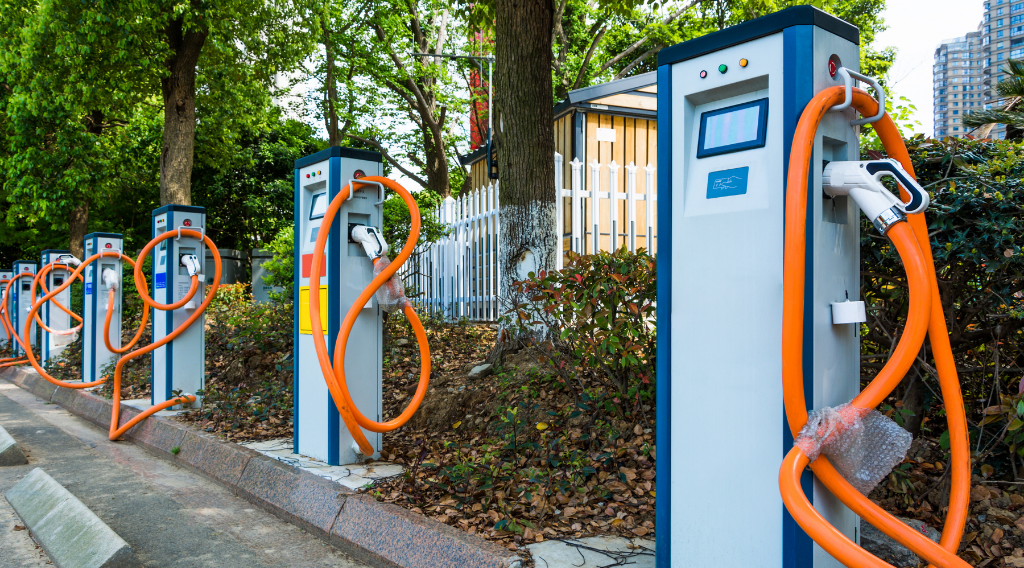EVs in the Twin Cities: Eden Prairie
November 30, 2021 | Rebecca Heisel | Education

Eden Prairie, Minnesota, a suburb of about 64,000 people, is among the first wave of cities in the nation to use an electric vehicle (EV) as a patrol vehicle for the city’s police department. I caught up with Jennifer Hassebroek, the sustainability coordinator for the City of Eden Prairie, to hear about the city’s new patrol vehicle and their process of electrifying the city’s fleet.
This post is part of a series of interviews with staff of Minnesota cities that are transitioning fleet vehicles to EVs. Cities interested in EVs can learn from the experiences of these cities, including Carver, Eden Prairie, Faribault, and Woodbury. Cities can also use the City Resource Database to find and connect with Minnesota cities that have incorporated EVs and EV charging infrastructure.
Electric Vehicles in City Fleet
The City of Eden Prairie has three EVs in its fleet: two Chevy Volts and a recently purchased Tesla Model Y. The inspection staff use the Volts, and the Tesla Model Y was outfitted to become a police cruiser.
Getting Started
Since Eden Prairie staff had already transitioned a few vehicles to EVs, they knew they wanted to continue purchasing EVs. They recognized transitioning their fleet vehicles to EVs doesn’t just happen overnight—it takes some foresight and planning. Jennifer Hassebroek reflected that key considerations for Eden Prairie’s transition to electric include the fleet vehicles’ replacement schedules, support from decision makers as well as city departments, and EV models available on the market.
Being forward-thinking, they looked to see which vehicles would be up for replacement in the future and identified a police cruiser that fit the bill. City council members, the fleet services director, and the police department were all on board with finding an electric alternative. While they were looking to continue adding EVs to their fleet, Eden Prairie was also developing a Climate Action Plan (which passed in March of 2020). The plan helps support and encourage the process of transitioning to EVs.
Purchasing EVs
When purchasing a vehicle for a police department, more functions need to be considered and accounted for that other departments may not need to worry about, such as handling and speed. With these specifications in mind, the fleet director researched vehicles and identified the Tesla Model Y as the best fit for the department.
Before bringing the proposal to the city council, city staff performed a full lifecycle cost analysis. The analysis showed a lifecycle cost savings when factoring in fuel and maintenance savings over the standard patrol vehicle the department was using, even though the EV’s initial purchase price was higher. With the city council looking to expand EVs in Eden Prairie’s fleet, they were supportive of the proposal. Receiving the vehicle took more time than usual because it had to be upfitted with modifications that are standard for law enforcement, like a roll cage, lights, and push bumper. In all, it took around seven months for the EV to be ready for delivery to Eden Prairie.
Vehicle Reception
At first, while the officers get used to the transition to an EV, the vehicle will be driven by a handful of people. So far, the officers assigned to the vehicle have shared positive feedback. And from the price and other metrics they’ve evaluated while the vehicle has been in use, it has been a successful pilot so far.
Eden Prairie will continue tracking metrics, such as the kilowatt-hours needed to charge the vehicle, to confirm that the savings will justify more EVs for the city fleet. Tracking the metrics will also be a helpful resource to share with their city council and sustainability commission. The metrics can also help other cities that reach out to them with questions about EVs.
Charging Capabilities
Eden Prairie has multiple charging stations installed at various facilities and is working with Xcel Energy to expand fleet charging capabilities. Initially, Tesla recommended not using a DC fast charger for everyday charging of a fleet vehicle. That guidance has now changed, and the city is in the process of installing a DC fast charger to better meet the police department needs. The officers that use the vehicle will plug it in for a boost whenever they are back at the station to do paperwork, for a meeting, or during their lunch break.
Advice for Other Cities
For other cities looking to make the shift to electric, Hassebroek suggests being innovative and creative with the transition and not being afraid to give those ideas a try. “We didn’t go out and convert all our vehicles to Teslas, we are starting out with this one, seeing how it goes, and evaluating it and will go from there,” she noted. While Eden Prairie is one of the first cities in the nation to add an EV to their fleet as police cruisers, Hassebroek emphasizes that usually, you can find some other city that has already made the transition who you can reach out to for their feedback on their EV experience. Eden Prairie has already had a handful of Minnesota cities contacting them to ask questions.
Looking Forward
Every year, with a large fleet of vehicles like in Eden Prairie, several cars come up for replacement. They hope to expand to utilize more EVs as older vehicles need replacement. In 2022 the city will be adding 8 fully electric vehicles to its fleet. Eden Prairie Mayor Ron Case has been pushing the city to have an aspirational goal of a completely electric fleet by 2030. Hassebroek said, “As we replace vehicles going forward, that’s always going to be our first thought—what electric versions are out there.”
Connecting with cities like Eden Prairie, which have made great strides in fleet electrification, could be helpful for your city’s journey. Use the City Resource Database to find and connect with Minnesota cities that have purchased EVs, installed charging infrastructure, and more.
